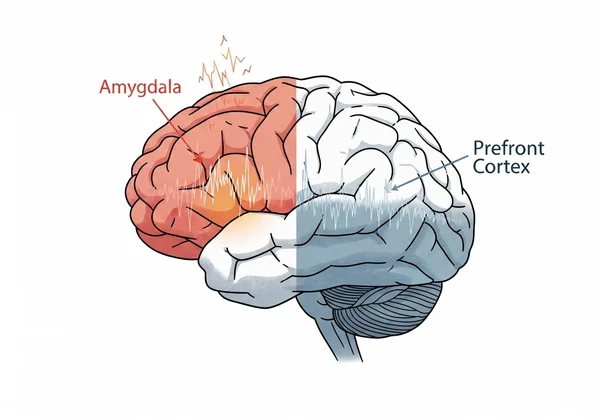PTSD & Depression: Understanding Overlap and How a Free PTSD Test Clarifies Symptoms
Feeling lost in a fog of difficult emotions is a heavy burden to carry. You might be grappling with persistent sadness, a sense of numbness, or intrusive memories that disrupt your daily life. It's common to wonder what's really going on. Is it trauma? Is it depression? The confusion is understandable, as the symptoms of Post-Traumatic Stress Disorder (PTSD) and depression can often look and feel remarkably similar. Many people ask, do I have PTSD or am I just traumatized?

This guide is here to offer clarity. We will explore the shared symptoms, uncover the key differences, and explain how a structured assessment can be a powerful first step toward understanding your experiences. Taking a moment for self-reflection can illuminate the path forward, and an online PTSD screening test provides a confidential starting point for that journey.
Understanding PTSD and Depression Symptoms
At first glance, PTSD and Major Depressive Disorder (MDD) share a significant amount of emotional territory. Both conditions can leave you feeling disconnected from others, exhausted, and struggling to find joy in activities you once loved. This overlap is not just a coincidence; it's rooted in how our brains process overwhelming stress and emotional pain. Understanding these shared struggles is the first step in untangling them.
Shared Struggles: Emotional Numbness, Anhedonia, and More
One of the most confusing overlaps is the feeling of being emotionally checked out. This emotional numbness can serve as a defense mechanism, a way for your mind to shield itself from overwhelming pain. It might feel like you're just going through the motions, detached from your own life.
Another common thread is anhedonia, a term psychologists use for the loss of pleasure or interest in activities that used to bring you joy. Hobbies, friendships, and even favorite foods can lose their appeal. This is often accompanied by social withdrawal, negative alterations in mood, sleep disturbances (either too much or too little), and difficulty concentrating. For someone experiencing these symptoms, distinguishing the root cause can feel impossible.
The Brain's Response: How Trauma Affects Mood Regulation
Why do these conditions overlap so much? The answer lies in our neurobiology. A traumatic event can dysregulate the body's stress response system, impacting the very parts of the brain responsible for mood regulation, memory, and emotional processing. The amygdala (the brain's "fear center") may become overactive, while the prefrontal cortex (responsible for reasoning and control) can become less effective.

This disruption can lead directly to the hyperarousal symptoms seen in PTSD, like being easily startled or constantly on edge. At the same time, the sustained stress and emotional toll can deplete neurotransmitters like serotonin and dopamine, which are crucial for maintaining a stable mood, contributing to the persistent low feelings characteristic of depression. Trauma can be a direct pathway to depression, or the two can develop concurrently, creating a complex clinical picture.
Distinguishing Between PTSD and Major Depressive Disorder
While the emotional fallout can feel similar, PTSD and depression are distinct conditions with unique diagnostic markers. Identifying these differences is crucial for seeking the right kind of support. While depression is primarily a mood disorder, PTSD is a trauma- and stressor-related disorder, meaning its symptoms are directly linked to a specific traumatic event or series of events. A confidential online PTSD test is designed to screen for these specific markers.

PTSD's Unique Markers: Intrusions, Avoidance, and Hyperarousal
The core features that set PTSD apart are tied directly to the traumatic memory. These are often grouped into four categories of symptoms:
- Intrusion Symptoms: This is perhaps the most well-known aspect of PTSD. It includes unwanted and distressing memories, flashbacks where you feel like you're reliving the event, and nightmares about the trauma. These intrusion symptoms are not just sad memories; they are vivid and involuntary re-experiences.
- Avoidance: A person with PTSD will go to great lengths to avoid reminders of the trauma. This can mean avoiding people, places, conversations, or activities that trigger distressing memories or feelings. This pattern of avoidance is a deliberate effort to keep the trauma at bay.
- Negative Alterations in Cognition and Mood: This looks a lot like depression but is rooted in the trauma. It includes persistent negative beliefs about oneself or the world (e.g., "I am bad," "The world is dangerous"), distorted blame, and an inability to experience positive emotions.
- Hyperarousal: This involves being in a constant state of high alert. Symptoms include irritability, angry outbursts, reckless behavior, being easily startled, and problems with concentration and sleep. This state of hyperarousal reflects a nervous system that is stuck in "fight or flight" mode.
Depression's Core Features: Persistent Sadness & Loss of Drive
In contrast, Major Depressive Disorder's core features are not necessarily linked to a specific intrusive memory. While trauma can be a trigger for depression, the symptoms can also arise without an identifiable external event. The defining characteristics of depression are:
- Persistent Sadness: A pervasive low mood or feeling of emptiness that is present most of the day, nearly every day.
- Loss of Drive: This is a profound loss of interest or pleasure in all, or almost all, activities—the clinical term is anhedonia. It's more than just being bored; it's a deep lack of motivation and enjoyment.
Other key symptoms include significant weight changes, sleep disruption, fatigue or loss of energy, feelings of worthlessness or excessive guilt, and recurrent thoughts of death or suicide. While someone with PTSD can experience these, in MDD, they form the central struggle without the requirement of intrusive, trauma-specific flashbacks or avoidance behaviors. Understanding your unique pattern is the first step, and a ptsd self test can help.
How a PTSD Test Can Clarify Your Symptom Profile

Navigating this complex emotional landscape on your own can be daunting. This is where a structured assessment tool provides immense value. A well-designed ptsd screening test acts as a mirror, reflecting your experiences back to you in an organized way. It helps you move from a vague sense of "something is wrong" to a clearer picture of your specific challenges.
The Role of Standardized Screening Tools (e.g., PCL-5)
Trustworthy online tests aren't random quizzes. Our test is based on the PCL-5 (PTSD Checklist for DSM-5), the same standard used by clinicians and researchers worldwide. This tool consists of a list of questions that directly correspond to the official diagnostic criteria for PTSD. By asking you to rate how much you've been bothered by specific symptoms over the past month, it systematically evaluates for the presence of intrusion, avoidance, and hyperarousal symptoms that are unique to PTSD. This structured approach helps quantify your experiences, making it easier to see if your symptom profile aligns more closely with PTSD.
Gaining Initial Insights for Professional Conversations
It is crucial to remember that an online test is a screening tool, not a diagnosis. A formal diagnosis can only be made by a qualified mental health professional. However, the results from a confidential test can be an invaluable starting point.
Instead of going to a doctor and saying, "I feel terrible," you can walk in with specific information: "I took a PCL-5 based screening, and my results suggest I am experiencing significant intrusive memories and avoidance behaviors." This empowers you to have a more focused and productive conversation with healthcare providers. It gives you the language to describe your inner world and provides them with a clearer picture from the very first appointment. Taking a free PTSD test is a proactive, private, and powerful step toward seeking the right help.
Your First Step Towards Clarity and Targeted Support
Feeling confused by overlapping symptoms of trauma and sadness is not a sign of weakness; it's a sign that you are trying to make sense of a difficult experience. Understanding the key differences between PTSD and depression is the first step toward finding the right path to healing. While both involve deep emotional pain, PTSD is uniquely defined by its direct link to a traumatic memory through intrusions, avoidance, and hyperarousal.
You don't have to navigate this uncertainty alone. Gaining clarity is possible, and it begins with a single, courageous step. By using a confidential and science-based tool, you can gain valuable insights into your symptoms and feel more prepared to seek professional guidance.
Ready to take that first step? Take our free PTSD test today to confidentially explore your symptoms and move toward a future with greater understanding and hope.
Frequently Asked Questions About PTSD & Depression
Do I have PTSD or anxiety?
This is another common point of confusion. Both involve intense worry and physical symptoms of arousal. However, the focus of the fear is different. Generalized Anxiety Disorder (GAD) often involves persistent worry about various aspects of life, like work, health, or family. In PTSD, the anxiety and hyperarousal are specifically linked to reminders of a traumatic event.
What happens if PTSD is left untreated?
If left untreated, PTSD symptoms can become chronic and severely impact all areas of life, including relationships, career, and physical health. It can increase the risk of developing other conditions like depression, substance use disorders, and other anxiety disorders. Seeking support is a critical step in preventing long-term complications.
Can PTSD go away?
With effective treatment, people can and do recover from PTSD. Therapies like Cognitive Behavioral Therapy (CBT) and Eye Movement Desensitization and Reprocessing (EMDR) are highly effective. While memories of the event will remain, treatment can significantly reduce or eliminate the distressing symptoms, allowing you to regain control of your life.
How accurate are online PTSD tests?
The accuracy of an online test depends entirely on its design. A test based on a clinically validated measure like the PCL-5, such as the online PTSD assessment offered here, can be a highly reliable screening tool. It provides a strong indication of whether your symptoms warrant further evaluation by a professional, serving as an accurate first step.
What to do after a ptsd test?
After taking a test, take a moment to review your results. Use them as a tool for self-reflection. The most important next step is to share these results with a trusted healthcare provider, such as a doctor or a licensed mental health professional. They can conduct a comprehensive evaluation, provide a formal diagnosis, and discuss the most effective treatment options for you.